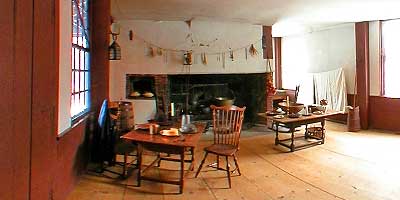|
Silas Deane Online
|

As we move to the back of the house, we will be leaving the rooms meant for entertainment of guests and for the comfort of family members. The back of the house is where the work was done, not by any members of Deane's family or stepfamily, but by the slaves. We have provided for you on Silas Deane Online a lesson, which discusses slavery in the north in general and tells you as much as we have so far discovered about the lives of two of the Deane family slaves, Pompey and Hagar. Hagar was the female slave who would have worked in this kitchen from sunup to sundown as she cooked and cleaned for the Deane family. Pompey was more likely to have been working outside in the gardens, stables and grounds of the Deane house, but he would have spent a great deal of time here in the kitchen eating, helping Hagar and keeping her company.
The kitchen is a fine example of a very well equipped and fancy cooking area for the 1770s. Notice the huge open hearth. The fire would be started first thing in the morning and kept going all day for boiling water, simmering stews and all other chores necessary for putting the main meal of the day on the dining room table. This would not be the half-hour task that gets your dinner on the table tonight, but a four or five hour labor for Hagar. Silas Deane had provided at least one very expensive timesaving device for his kitchen workers. Notice the brass contraption to the left of the hearth. This is called a clock jack (see image) and you see a similar tool today at Boston Market or on a fancy outdoor gas barbecue. Hit the link to learn more about its use. Under the window to the right of the fireplace is another item made from the Portland brownstone of the front parlor fireplace surround. The water for the sink would have been lugged in heavy buckets from the well outside the kitchen door (see image), but once the water was poured into the brownstone sink and the dishes and pot and pans scoured, the water could be let out when the wooden drain plug was removed. Most dishwashers in the 1770s would also have had to carry out the dirty water in heavy wooden buckets.
Please also notice the much smaller back door where the slaves and servants and their friends would have entered. In the slavery lesson you can learn about one special friend of Hagar and Pompey, Cloe Prut, who probably visited them through that very door. You can also learn where the three of them spent the years of their lives after Silas died.